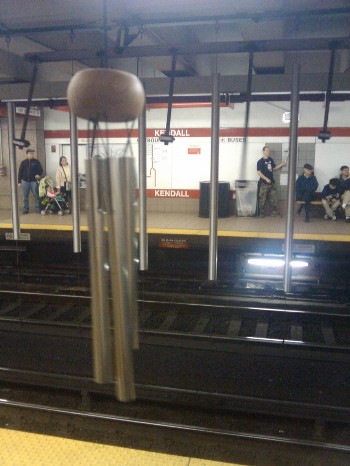Visual Arts: Pythagoras Returns — Sound Sculpture at Kendall T Stop Chimes Again (Revised)
What the artist didn’t count on was the popularity of the Kendall Band, coupled with its fragility relative to the strength and number of its users, would result in frequent breakdowns. The Kendall Band was the only interactive piece of public art in the MBTA’s “Arts on the Line” program, and the agency had no funds set aside for ongoing repairs.
By Margaret Weigel

The re-dedication of Pythagoras — a mix of music, visual art, subways cars, and party at the Kendall Square T stop. Photo: Margaret Weigel
The artist Paul Matisse realized early in the installation process that that his three large, sonic arts sculptures—suspended between the tracks of the Kendall Square subway stop and operated by the station’s commuters—were perhaps not the most durable works one could install in a public space. “You’d probably have to say it was folly of me to press ahead and [create] something that had moving parts,’’ Matisse told the Boston Globe in 2010. “I figured it was going to be all right.’’
Paul Matisse talks about the Kendall Band
But press ahead he did, and the outcome, a piece called the Kendall Band, has graced the Kendall Station on the red line since 1987. The Kendall Band consists of three discrete pieces. “Pythagoras” is a series of tubular bells turned to B minor that plays a harmonious chord when swung with sufficient force. “Kepler” is a single 125lb, 55-inch metal ring that plays a clear F sharp when struck by a crank-released hammer. And “Galileo” is a large, metal sheet that sounds like thunder, or an approaching train, when operated.
The project was fraught with technical mishaps from the start. Matisse, the grandson of the 19th-century painter Henri Matisse, had previously constructed a musical fence out of a series of finely-tuned lengths of pipe for the city of Cambridge that was removed after the city received complaints from sleep-deprived residents living nearby.
His new work, the Kendall Band, was also to suffer at the hands of its intended audience, the general public. To minimize direct interaction with the works, Matisse deliberately positioned the three components of the “Kendall Band” between the tracks, thinking that if the work was hung between concrete supports, flanked by the protective powers of the third rail and operated by a connection of handles on the subway platforms, vandals or overly enthusiastic fans would be kept from damaging the piece.
What he didn’t count on was the popularity of the Kendall Band, coupled with its fragility relative to the strength and number of its users, would result in frequent breakdowns. The Kendall Band was the only interactive piece of public art in the MBTA’s “Arts on the Line” program, and the agency had no funds set aside for ongoing repairs. After 20 years of heading down into the subway in the wee hours and repairing the pieces himself, the 74-year-old Matisse decided to step away and let nature and commuters take their due course. The MBTA, after financing a one-time repair in 2007, would not pledge additional support for the Kendall Band’s upkeep, and the work— surprise—quickly broke down.
The Kendall Band and MIT Musicians
A concerned commuter contacted Clarise E. Snyder in Massachusetts Institute of Technology’s (MIT’s) Musical and Theatre Arts department to see if MIT could lend a hand in some way. Synder then passed the word around campus and Michael J. Tarkanian, an instructor in the university’s Department of Materials Science and Engineering, was tapped to supervise a core group of 20 students—dubbed the Kendall Band Preservation Society—to refurbish Matisse’s work.
On Saturday April 30, 2011, the tubular bells of “Pythagoras” were back in the station once again, ringing out various B minor chords to the delight Snyder, Tarkanian, Matisse, and a small, supportive crowd gathered on the Inbound platform for the re-dedication. After the speeches, a quarter of MIT student musicians under the direction of composer and pianist Donal Fox, played along with “Pythagoras,” spinning an ethereal sonic mix of violin and bells that transformed the humble subway platform into a place to be rather than a place to wait to leave.
The Kendall Band performs along with subway announcements
The music was punctuated by intelligible announcements from the T and the periodic roar of the trains, and yet somehow it all worked together. One commuter stepped through the train doors, then turned back onto the platform, deciding to linger a bit longer to listen to the mix of violins, bells, commuters, and locomotives. There will always be another train, after all.
Tagged: Galleries, Kendall Band, Kendall Band Preservation Society, MIT, Paul Matisse, Pythagoras


